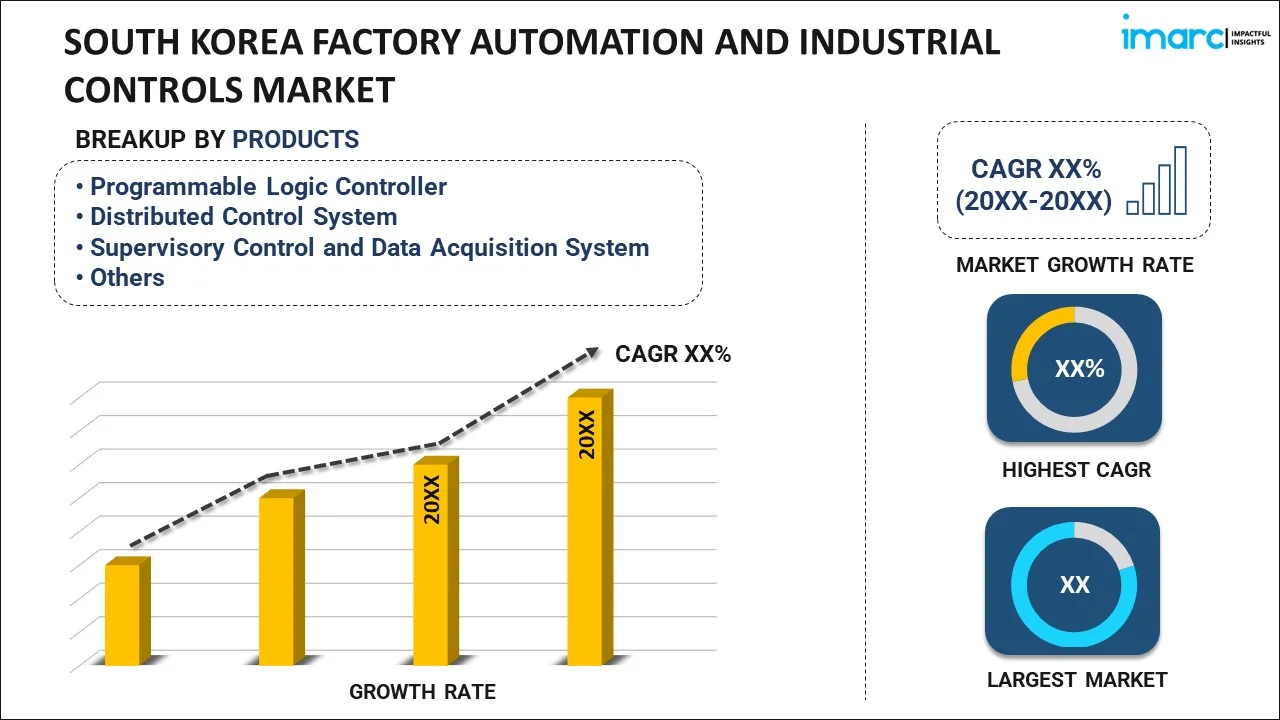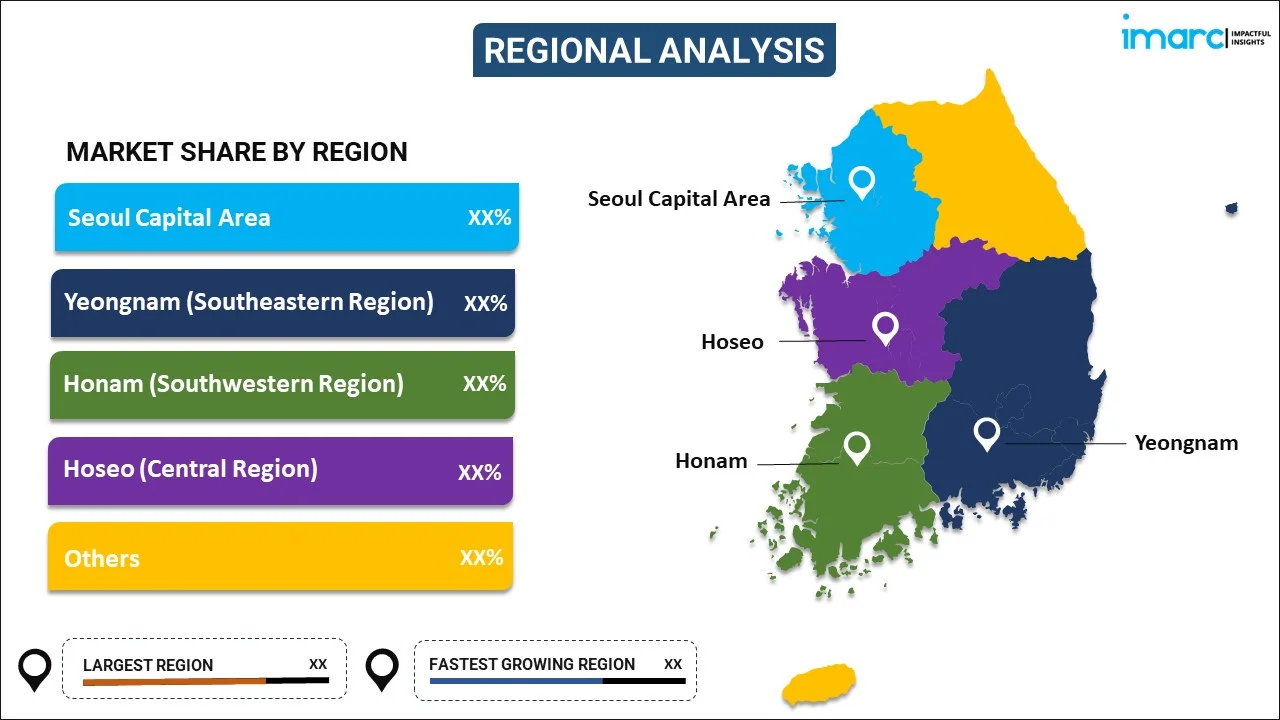
South Korea Factory Automation and Industrial Controls Market Report by Product (Programmable Logic Controller (PLC), Distributed Control System (DCS), Supervisory Control and Data Acquisition System (SCADA), Human Machine Interface (HMI), Process Safety Systems, Sensors and Transmitters, Electric Motors, Variable Frequency Drives, Industrial Robotics, and Others), End Use Industry (Automotive, Chemical and Petrochemical, Semiconductor and Electronics, Oil and Gas, Power Generation, Water and Wastewater, and Others), and Region 2024-2032
Market Overview:
South Korea factory automation and industrial controls market size is projected to exhibit a growth rate (CAGR) of 6.90% during 2024-2032. The rising automation needs in manufacturing, increasing focus on improving operational efficiency, the expanding adoption of Industry 4.0 technologies, and the implementation of favorable government initiatives to enhance industrial competitiveness represent some of the key factors driving the market.
|
Report Attribute
|
Key Statistics
|
|---|---|
|
Base Year
|
2023 |
|
Forecast Years
|
2024-2032
|
|
Historical Years
|
2018-2023
|
| Market Growth Rate (2024-2032) | 6.90% |
Factory automation and industrial controls are integral components of modern manufacturing processes designed to enhance efficiency, productivity, and precision in industrial settings. Factory automation refers to the use of various technologies and systems to streamline and optimize production processes, reducing the need for human intervention and the risk of errors. This encompasses a wide range of automation tools, from robotic arms and conveyors to computerized systems that monitor and control various aspects of production, including material handling, assembly, quality control, and packaging. By automating these tasks, factories can significantly increase their output, reduce labor costs, improve product consistency, and enhance workplace safety. Industrial controls, on the other hand, are the core technologies that enable the automation of processes within a factory or industrial facility. This includes programmable logic controllers (PLCs), distributed control systems (DCS), human-machine interfaces (HMIs), and various sensors and actuators. Together, these components enable precise and responsive control over manufacturing processes, reducing waste, improving quality, and ultimately driving industrial efficiency.
South Korea Factory Automation and Industrial Controls Market Trends:
South Korea's strong industrial base, including the automotive, electronics, and semiconductor industries, is consistently seeking ways to enhance productivity and competitiveness. This demand for improved efficiency and precision in manufacturing processes has fueled the adoption of factory automation and industrial control systems, primarily driving the market growth. Moreover, the global trend toward smart manufacturing, Industry 4.0, and the Internet of Things (IoT), which heavily rely on industrial automation and control systems to enable real-time data monitoring and adaptive production processes, is acting as another significant growth-inducing factor. In line with this, the increased need for precision and quality in manufacturing, especially in sectors like electronics, where even slight errors can lead to significant losses, is presenting lucrative opportunities for market expansion. Concurrently, the growing labor costs in South Korea are pushing manufacturers to automate routine and repetitive tasks, thus reducing dependence on manual labor and increasing overall cost-efficiency, which, in turn, is contributing to the market growth. In addition to this, the South Korean government has been actively supporting the adoption of automation and control technologies through various initiatives, tax incentives, and investment programs, creating a favorable outlook for market expansion. Furthermore, the necessity for traceability and compliance with stringent industry regulations has prompted the integration of control systems for data logging, tracking, and reporting in various industries, such as pharmaceuticals and food processing, bolstering the market growth. Apart from this, the rapid expansion of the e-commerce sector has surged demand for automated warehousing and logistics systems, utilizing robotics and control technologies to efficiently manage inventory, order fulfillment, and delivery, thus propelling the market forward.
South Korea Factory Automation and Industrial Controls Market Segmentation:
IMARC Group provides an analysis of the key trends in each segment of the market, along with forecasts at the country level for 2024-2032. Our report has categorized the market based on product and end use industry.
Product Insights:

- Programmable Logic Controller (PLC)
- Distributed Control System (DCS)
- Supervisory Control and Data Acquisition System (SCADA)
- Human Machine Interface (HMI)
- Process Safety Systems
- Sensors and Transmitters
- Electric Motors
- Variable Frequency Drives
- Industrial Robotics
- Others
The report has provided a detailed breakup and analysis of the market based on the product. This includes programmable logic controller (PLC), distributed control system (DCS), supervisory control and data acquisition system (SCADA), human machine interface (HMI), process safety systems, sensors and transmitters, electric motors, variable frequency drives, industrial robotics, and others.
End Use Industry Insights:
- Automotive
- Chemical and Petrochemical
- Semiconductor and Electronics
- Oil and Gas
- Power Generation
- Water and Wastewater
- Others
A detailed breakup and analysis of the market based on the end use industry have also been provided in the report. This includes automotive, chemical and petrochemical, semiconductor and electronics, oil and gas, power generation, water and wastewater, and others.
Regional Insights:

- Seoul Capital Area
- Yeongnam (Southeastern Region)
- Honam (Southwestern Region)
- Hoseo (Central Region)
- Others
The report has also provided a comprehensive analysis of all the major regional markets, which include Seoul Capital Area, Yeongnam (Southeastern Region), Honam (Southwestern Region), Hoseo (Central Region), and others.
Competitive Landscape:
The market research report has also provided a comprehensive analysis of the competitive landscape in the market. Competitive analysis such as market structure, key player positioning, top winning strategies, competitive dashboard, and company evaluation quadrant has been covered in the report. Also, detailed profiles of all major companies have been provided.
South Korea Factory Automation and Industrial Controls Market Report Coverage:
| Report Features | Details |
|---|---|
| Base Year of the Analysis | 2023 |
| Historical Period | 2018-2023 |
| Forecast Period | 2024-2032 |
| Units | US$ Million |
| Scope of the Report | Exploration of Historical and Forecast Trends, Industry Catalysts and Challenges, Segment-Wise Historical and Predictive Market Assessment:
|
| Products Covered | Programmable Logic Controller (PLC), Distributed Control System (DCS), Supervisory Control and Data Acquisition System (SCADA), Human Machine Interface (HMI), Process Safety Systems, Sensors and Transmitters, Electric Motors, Variable Frequency Drives, Industrial Robotics, Others |
| End Use Industries Covered | Automotive, Chemical and Petrochemical, Semiconductor and Electronics, Oil and Gas, Power Generation, Water and Wastewater, Others |
| Regions Covered | Seoul Capital Area, Yeongnam (Southeastern Region), Honam (Southwestern Region), Hoseo (Central Region), Others |
| Customization Scope | 10% Free Customization |
| Report Price and Purchase Option | Single User License: US$ 3699 Five User License: US$ 4699 Corporate License: US$ 5699 |
| Post-Sale Analyst Support | 10-12 Weeks |
| Delivery Format | PDF and Excel through Email (We can also provide the editable version of the report in PPT/Word format on special request) |
Key Questions Answered in This Report:
- How has the South Korea factory automation and industrial controls market performed so far and how will it perform in the coming years?
- What has been the impact of COVID-19 on the South Korea factory automation and industrial controls market?
- What is the breakup of the South Korea factory automation and industrial controls market on the basis of product?
- What is the breakup of the South Korea factory automation and industrial controls market on the basis of end use industry?
- What are the various stages in the value chain of the South Korea factory automation and industrial controls market?
- What are the key driving factors and challenges in the South Korea factory automation and industrial controls?
- What is the structure of the South Korea factory automation and industrial controls market and who are the key players?
- What is the degree of competition in the South Korea factory automation and industrial controls market?
Key Benefits for Stakeholders:
- IMARC’s industry report offers a comprehensive quantitative analysis of various market segments, historical and current market trends, market forecasts, and dynamics of the South Korea factory automation and industrial controls market from 2018-2032.
- The research report provides the latest information on the market drivers, challenges, and opportunities in the South Korea factory automation and industrial controls market.
- Porter's five forces analysis assist stakeholders in assessing the impact of new entrants, competitive rivalry, supplier power, buyer power, and the threat of substitution. It helps stakeholders to analyze the level of competition within the South Korea factory automation and industrial controls industry and its attractiveness.
- Competitive landscape allows stakeholders to understand their competitive environment and provides an insight into the current positions of key players in the market.
Need more help?
- Speak to our experienced analysts for insights on the current market scenarios.
- Include additional segments and countries to customize the report as per your requirement.
- Gain an unparalleled competitive advantage in your domain by understanding how to utilize the report and positively impacting your operations and revenue.
- For further assistance, please connect with our analysts.
 Inquire Before Buying
Inquire Before Buying
 Speak to an Analyst
Speak to an Analyst
 Request Brochure
Request Brochure
 Request Customization
Request Customization




.webp)




.webp)












